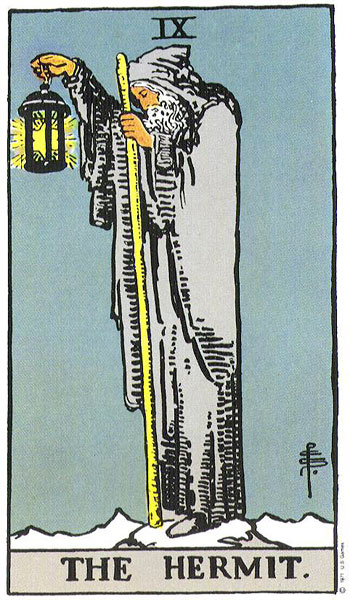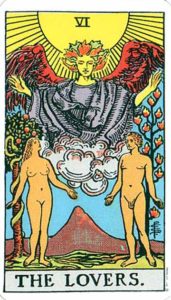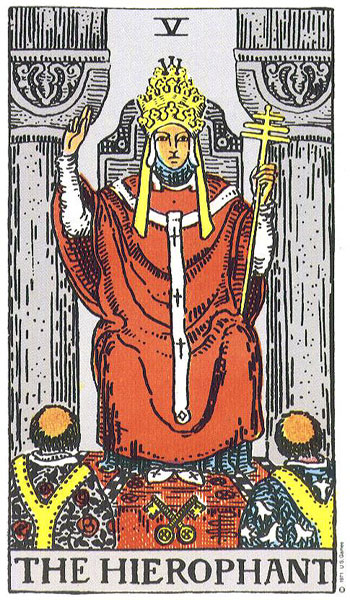The first step
towards gaining a deeper understanding of the Tarot, and something a lot
of people forget to do, is to break down the 56 minor arcana cards into
14 groups - the aces, the twos, threes, and so on. So instead of having
56 cards, you only have one set of 14 cards, each with four different
suits, coupled with a card from the major arcana as an influence of
those cards. In a previous post we discussed the suits and the
difference aspect they symbolise, now it's just a matter or leaning the
14 different groups of cards, and their relationship with their "parent"
major arcana.
In this lesson, we shall be discussing The Hierophant and the fives
The Hierophant & The Fives
The Hierophant
The fives relate to the hierophant, a high priest. He sits perched upon his throne as two other holy men kneel before him. We see a man who leads his flock and shared communal rituals. Remember, he is the leader of a flock - not of individuals. The hierophant focuses on the group, leading them to their destiny, soothing their worries and fears. His power comes from tradition and consistency, providing his followers with comfort through stability. He also represents mercy and goodness, compassion, inspiration, and alliances.
The Fives
Fives are about the instability in loss, severity and fear. If you picture the four corners of a building, like we described in our overview of the fours, you can see that if there's any space inside the fifth stone cannot be supported in any symmetrical way. The fifth stone may lie in the middle of an empty space, or be placed upon another stone - thus creating asymmetry. Some loss of the perfection we had as fours is represented by the fives. However, it is not a total loss, progress continues to be made, but there are periods of struggle; times when things don't align. This is the time of the fives, but, fives also remind us of the strength that is gathered from these difficult times. The fives present a severe problem, yet also point to a way of escaping it. Give up? Or continue building? Dealing with this upset in the development of our passion, (or idea, or our work) humbles us, it teaches us and matures us. It is however not a pleasant experience and our pride especially is likely to suffer, but it strengthens us nevertheless.
The Five of Swords
The five of swords depicts a man successful in battle, watching his vanquished foes depart. The card depicts winners and losers. That all of these men were equipped for battle indicates that this was not a game played by novices, but rather a competition of importance. The victor holds their swords in his left hand and his own sword, now at rest, being held to the ground. He has clearly defeated others as is shown by the other swords on the ground. He is overconfident. This card serves as a warning against pride and overconfidence. The losers departing disarmed and in disgrace, shrink away into the distance. What lessons will they take away from this? Had they been tricked into a losing battle? Did they let their own overconfidence shield them from the realities they faced? Either character may represent the querant. Whether the querant is winning or losing this card serves as a warning against overconfidence, and the dangers of rushing in too soon.
The Five of Wands
The five of wands depicts children of a younger age engaging in play and mock fighting. The activities of youth which teach the beginnings, they serve as training for more serious pursuits. Imitations, a sham fight, a quest for achievement. The competitors in this card are of equal stature and position. This is not a struggle against Goliath but rather a struggle against those on equal footing. The inexperience and apparent lack of consequences may appear to make this game even unimportant. However, as we saw with the five of swords it is from winning these small battles that the opportunity is gained to partake and excel in the greater ones.
The Five of Cups
The five of cups depicts spilt cups with a man in black sobbing in sorrow over their emptiness. His back is turned away from the cups that remain standing and full behind him. In relation to the suit of cups, a sign of passion, in this card we see broken heartedness and disappointment. However, this card can serve as a reminder that when you turn your back on emptiness you can find fulfilment. This card might be related to the idea of crying over spilt milk, particularly when that milk pertains to the way we invest in our passion with our efforts. Loss is perhaps the most painful when we turn our back on those things that we once loved, and focus only on the things that are gone. This card also signifies one who's perceived less than they had expected.
The Five of Pentacles
The five of pentacles depicts a couple cold and poorly clothed, exposed to the elements and injured. They pass by a church with an opulent stain glass window. They do not stop in the church to warm up, they just pass by. But why? Remembering that fives reflect upon difficult times, the characters on the card may be shunned from this congregation, or viewed by this society as unfit. But notice - they remain together. The pentacles relate to material possessions, wealth and health, but the two people on the card remain together though they appear to have none of these things. This is a card of misery, but also one of hope, and a reminder of the constant support of others who surround you at any moment in time. It is a reminder that true friends, true partners, will stand by you and weather the storm with you. This couple may be rejected by one society, but they have now created their own. It may be very small, a society of only two for now, and others who are similarly situated may not seem to be close by - but if you seek them out, you will find them. The potential for loss may be devastating, but as this card depicts - you can never lose everything.














